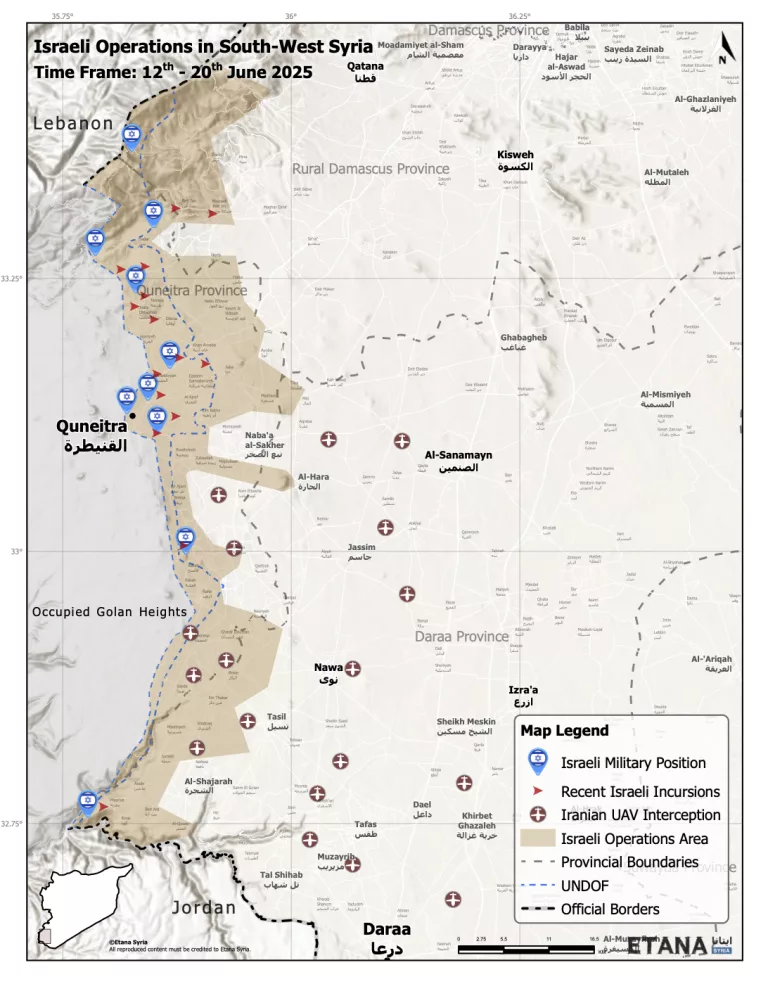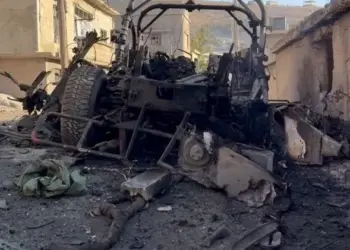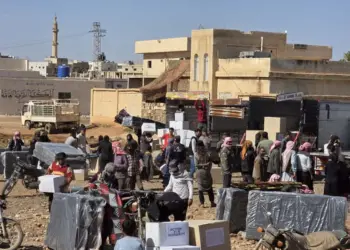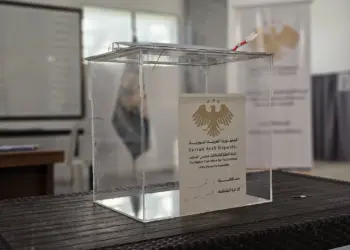One week ago, Israel launched a wave of aerial attacks targeting Iranian nuclear facilities, military and Islamic Revolutionary Guards Corps (IRGC) commanders and scientists, and other key infrastructure across Iran. Iran has retaliated with several barrages of high-speed ballistic missiles and drones. Both states have repeatedly utilized Syrian airspace to conduct cross-regional attacks, with interim authorities effectively powerless to intervene and keen to limit the threat of spillover hostilities.
Syria now stands in the middle of an ever-escalating regional conflict between Israel and Iran. While the extent of the damage to Iran’s abilities to continue fighting remains unknown for now, an ongoing war could push Iran to activate what remains of its proxies in and around Syria, particularly as Hezbollah in Lebanon has refrained from participating. As attacks continue, internal tensions in an already fractious Syria are rising. At the same time, while an increasingly clear Israeli ambition to overthrow Iran’s regime may be curtailed by a more reserved position from the Trump administration, only existential threats to the Iranian regime are likely to prompt an escalation that would directly affect Syria.
Potential for involvement
The Israel-Iran war deepens existing vulnerabilities within Syria’s already fragile security situation, vulnerabilities that Iran could take advantage of depending on the course of the highly volatile and unpredictable cross-region conflagration now underway. One potential move could see Iran recruiting fighters in south Syria to carry out further attacks against Israel, regardless of the effectiveness or precision of such attacks. As well as perpetuating ongoing hostilities in the region, these incidents could exacerbate tensions between Israel and the new Damascus authorities.
Even as Damascus stays quiet, other forces could pull Syria into the war. In early June, before the outbreak of Israel-Iran hostilities, unknown militants conducted the first cross-border rocket launch targeting the Israeli-occupied Golan Heights since the fall of the former regime. This attack was claimed by a group calling itself the “Islamic Resistance Front in Syria”/Awli al-Ba’is. In retaliation, Israel launched airstrikes and artillery barrages targeting several locations in south Syria, with Defense Minister Israel Katz holding interim President Ahmad al-Shara’a “directly responsible for every threat and fire” towards Israeli-held territory and warning that “[Israel] will not allow a return to the reality of 7th October.”
Tactically, Israel’s full use of Syrian airspace, which is in violation of the country’s sovereignty, has facilitated the interception of Iranian missiles and drones over Syria before reaching their targets. It also enabled mid-air refueling of Israeli aircraft en route to Iranian airspace. The current post-Assad state of Syria, with its air defense capabilities nearly destroyed, allows Israeli aircrafts to operate freely without fear of Syrian or Russian-operated defenses, most of which are now destroyed or unmanned. The new administration is also unwilling to use such systems to avoid provoking Israel.
Syria’s weak defense capabilities
With Syria’s air defense capabilities either unmanned or destroyed in the wave of Israeli airstrikes following the removal of the Assad regime, interim authorities can do little but stand by as Israel and Iran use Syrian airspace for their own ends. The country’s weak air defense is due in part to Israel’s military campaign in Syria immediately after the fall of Assad and the interim authorities’ struggle to organize a new army. Starting in December 2024, Israel instigated an unprecedented and unprovoked aerial campaign targeting military equipment and sites across Syria in an effort to demilitarize the country. These attacks all but destroyed the majority of Syria’s air defense infrastructure. As a result, Syria is unable to defend its own airspace, allowing for major powers to use Syria—yet again—as a battlefield for their own wars and ambitions.
On the ground, interim authorities are still in the painstaking process of integrating armed groups and forming a new army. So far, divisions operating under the interim Ministry of Defense exist largely on paper, with a unified, professionalized command-and-control structure still something that exists more in theory than in practice.
Syria is already feeling the effects of the Israel-Iran war. So far, the war has also displaced nearly 1,000 residents of Quneitra, with more than 100 Iranian missiles and drones intercepted and downed in Daraa and Quneitra since the conflict began. Media outlets report that one woman was killed when a downed Iranian drone crashed into her home in the Tartous countryside.
Post-Assad Israeli campaigns
In the immediate aftermath of the regime’s collapse, the Israeli army effectively occupied the UNDOF-monitored demilitarized border strip between the occupied Golan and Syrian-controlled Quneitra in violation of Syria’s sovereignty. Perpetuating instability in the south, Israel has been conducting regular incursions, raids and aerial attacks in Quneitra and Daraa since then.
Israel’s expansion in south Syria, a footnote now amid the unfolding conflict between Israel and Iran, has been rejected by residents. Israeli military attempts at outreach, including the establishment of an Israeli field hospital and aid distribution, have been rejected by communities in Quneitra, who have faced destruction of their homes and farmlands, casualties, displacement, arbitrary arrests and curfews amid unchecked Israeli military operations. In late March, Israeli forces advancing in Koya, south-west Daraa, were met with resistance from local fighters, in clashes that displaced at least 3,000 civilians. A subsequent Israeli drone strike on the area killed several individuals.
There are already signs that the latest conflict in region is hardening Israel’s occupation in the south: in recent days, Israeli forces have destroyed civilian housing, swathes of agricultural land and forests to improve reconnaissance deep into Syrian territory.
Diplomatic silence
On the political front, the escalation has been met with relative silence from Damascus. Interim authorities recognize their relatively weak hand and appear keen to avoid being dragged into another war. Interim authorities appear to be doing their utmost to demonstrate to Israel a picture of compliance, removing earthen berms close to the border strip that could limit Israeli reconnaissance and reinforcing Ministry of Defense units’ presence along the Syrian-Iraqi border to limit the risk of Iranian-backed militias—not least Hashd al-Sha’abi (the Popular Mobilization Units, PMU)—seeking to escalate in a new theater.






